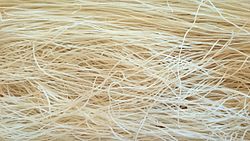Rice vermicelli

Strands of rice vermicelli
|
|
| Alternative names | Rice noodles, rice sticks |
|---|---|
| Type | Rice noodles |
| Place of origin | China |
| Main ingredients | Rice |
| Variations | Guilin mǐfěn |
| |
|
| Rice vermicelli | |||||||||||||||||||||||||||||||
| Chinese name | |||||||||||||||||||||||||||||||
|---|---|---|---|---|---|---|---|---|---|---|---|---|---|---|---|---|---|---|---|---|---|---|---|---|---|---|---|---|---|---|---|
| Chinese | 米粉 | ||||||||||||||||||||||||||||||
|
|||||||||||||||||||||||||||||||
| Vietnamese name | |||||||||||||||||||||||||||||||
| Vietnamese | bún | ||||||||||||||||||||||||||||||
| Thai name | |||||||||||||||||||||||||||||||
| Thai | เส้นหมี่ (sen mee) | ||||||||||||||||||||||||||||||
| Japanese name | |||||||||||||||||||||||||||||||
| Kana | ビーフン (bīfun) | ||||||||||||||||||||||||||||||
| Malay name | |||||||||||||||||||||||||||||||
| Malay | bihun | ||||||||||||||||||||||||||||||
| Filipino name | |||||||||||||||||||||||||||||||
| Tagalog | bihon or bijon | ||||||||||||||||||||||||||||||
| Tamil name | |||||||||||||||||||||||||||||||
| Tamil | சேவை (sevai) | ||||||||||||||||||||||||||||||
| Transcriptions | |
|---|---|
| Standard Mandarin | |
| Hanyu Pinyin | mífěn |
| Wu | |
|
Shanghainese Romanization |
mi3 fen1 |
| Hakka | |
| Romanization | mi fun |
| Yue: Cantonese | |
| Jyutping | mai3 fen2 |
| Southern Min | |
| Hokkien POJ | bí-hún |
| Eastern Min | |
| Fuzhou BUC | mī-hūng |
| Pu-Xian Min | |
| Hinghwa BUC | bî-heông |
Rice vermicelli are a thin form of rice noodles. They are sometimes referred to as rice noodles, rice sticks, or bee hoon, but they should not be confused with cellophane noodles, which are an Asian type of vermicelli made from mung bean starch rather than rice.
Rice vermicelli are a part of several Asian cuisines, where they are often eaten as part of a soup dish, stir-fry, or salad. One particularly well-known, slightly thicker variety, called Guilin mǐfěn (桂林米粉), comes from the southern Chinese city of Guilin, where it is a breakfast staple.
Beginning July 1st, 2014, Food and Drug Administration of Taiwan rules that only products made 100% of rice can be labeled and sold as "米粉" in Taiwan, usually translated as "rice vermicelli" or "rice noodle". If the product contains starch or other kinds of grain powder as ingredients but is made of at least 50% percent of rice, it is to be labeled as "調和米粉", meaning "blended rice vermicelli". Products made of less than 50% of rice cannot be labelled as rice vermicelli.
In Malaysia, the rice vermicelli can be called and found as Mihun, Mi hoon, Mee Hoon, Bihun, or Bee Hoon.
...
Wikipedia
